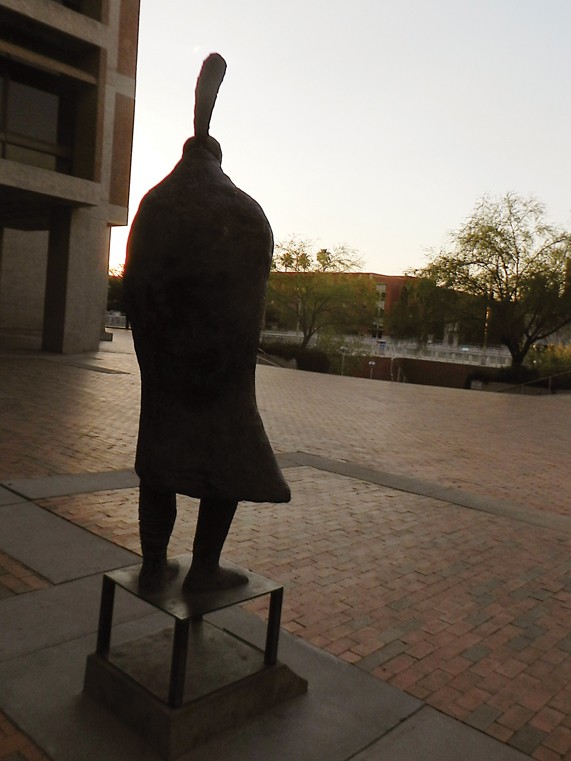The UA houses a collection of treasures that often go unnoticed, even though we walk by them every day. With over 40 sculptures and memorials on the campus, the UA has amassed an exceptional variety of artwork that anyone can access and admire.
Three incredible pieces sit by some of the university’s most important buildings. Each has its own story of creativity, history and courage.
In 1994, UA alum Fritz Scholder created the Native American sculpture that now stands in front of the UA Main Library.
“Another Martyr No. 4” is a bronze piece depicting a mysterious figure with a skull-like face and a single feather crowning its head.
From the 1960’s, when he was accepted into the Rockefeller Indian Art Project at UA, to his death in 2005, Scholder’s art reflected the inner turmoil he held about his heritage as a Luiseño tribal member. The introduction to the Smithsonian Institution’s National Museum of the American Indian exhibition “Fritz Scholder: Indian/Not Indian” said, “Scholder’s life and art were a study in contradictions. He was an enrolled Luiseño tribal member who often said he was not Indian. He was one of the most famous Indians of his time, despite a tendency to be reclusive. And although many of his works contain no obvious Indian imagery, he was a leader in a generation of artists who changed Indian painting forever.”
Next time you walk by the UA Main Library, stop to admire the sculpture that mirrors one artist’s struggle to find his identity.
On the south side of the Student Union Memorial Center, the sound of wind chimes can be heard on a windy day. But what actually produces this eerie and magical noise are thousands of dog tags which hang from Susan Gamble’s U.S.S Arizona Memorial, “Those Who Gave Their Lives.”
In 2003, the new SUMC was completed in the image of the U.S.S Arizona, which was destroyed in Pearl Harbor in 1941.
According to Lauren Rabb, curator at the UA Museum of Art, “The sculpture was created with the addition of 1,511 dog tags, each with the name of an individual assigned to the ship. The sculpture represents an 18-foot ship’s mast, 12 feet wide at the tip, with strings of military-style identification tags wound around to allude to the rigging.”
The memorial serves as not only a patriotic tribute, but an irreplaceable piece of historical art.
Tucked away next to the Center for Creative Photography is the Harvill building, and on its large cement patio which faces Olive Road, are four metal figures pushing against opposite sides of a giant fence. “Border Dynamics” was crafted by Alberto Morackis and Guadalupe Serrano as part of the artist’s collective, Taller Yonke.
In a 2004 interview with the Tucson Weekly, Morackis spoke about why he choose to be involved in creating border artwork, “The U.S. put the wall up without discussion. Art is part of the discussion. The border is an issue that art can say a lot about.”
“Border Dynamics” was originally made as a much larger installment set in Nogales, Ariz., but U.S. officials were worried it would help migrants crawl over the fence, according to Rabb.
These uniquely historical and culturally important works are just an example of the vast gathering of outdoor art installations the UA has to offer.









